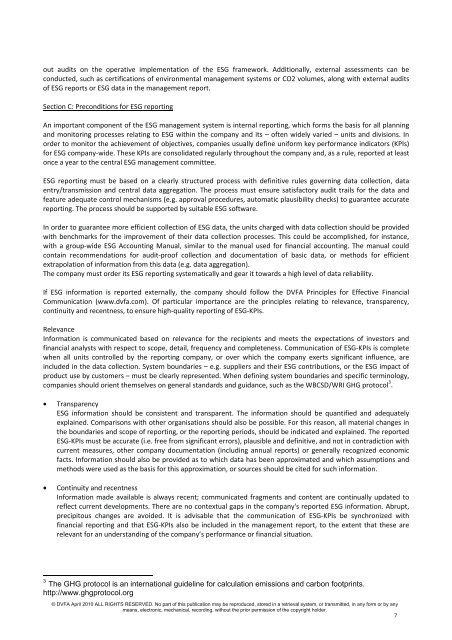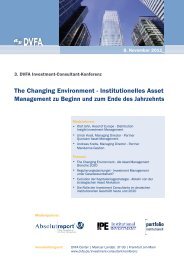KPIs for ESG - DVFA
KPIs for ESG - DVFA
KPIs for ESG - DVFA
Create successful ePaper yourself
Turn your PDF publications into a flip-book with our unique Google optimized e-Paper software.
out audits on the operative implementation of the <strong>ESG</strong> framework. Additionally, external assessments can be<br />
conducted, such as certifications of environmental management systems or CO2 volumes, along with external audits<br />
of <strong>ESG</strong> reports or <strong>ESG</strong> data in the management report.<br />
Section C: Preconditions <strong>for</strong> <strong>ESG</strong> reporting<br />
An important component of the <strong>ESG</strong> management system is internal reporting, which <strong>for</strong>ms the basis <strong>for</strong> all planning<br />
and monitoring processes relating to <strong>ESG</strong> within the company and its – often widely varied – units and divisions. In<br />
order to monitor the achievement of objectives, companies usually define uni<strong>for</strong>m key per<strong>for</strong>mance indicators (<strong>KPIs</strong>)<br />
<strong>for</strong> <strong>ESG</strong> company-wide. These <strong>KPIs</strong> are consolidated regularly throughout the company and, as a rule, reported at least<br />
once a year to the central <strong>ESG</strong> management committee.<br />
<strong>ESG</strong> reporting must be based on a clearly structured process with definitive rules governing data collection, data<br />
entry/transmission and central data aggregation. The process must ensure satisfactory audit trails <strong>for</strong> the data and<br />
feature adequate control mechanisms (e.g. approval procedures, automatic plausibility checks) to guarantee accurate<br />
reporting. The process should be supported by suitable <strong>ESG</strong> software.<br />
In order to guarantee more efficient collection of <strong>ESG</strong> data, the units charged with data collection should be provided<br />
with benchmarks <strong>for</strong> the improvement of their data collection processes. This could be accomplished, <strong>for</strong> instance,<br />
with a group-wide <strong>ESG</strong> Accounting Manual, similar to the manual used <strong>for</strong> financial accounting. The manual could<br />
contain recommendations <strong>for</strong> audit-proof collection and documentation of basic data, or methods <strong>for</strong> efficient<br />
extrapolation of in<strong>for</strong>mation from this data (e.g. data aggregation).<br />
The company must order its <strong>ESG</strong> reporting systematically and gear it towards a high level of data reliability.<br />
If <strong>ESG</strong> in<strong>for</strong>mation is reported externally, the company should follow the <strong>DVFA</strong> Principles <strong>for</strong> Effective Financial<br />
Communication (www.dvfa.com). Of particular importance are the principles relating to relevance, transparency,<br />
continuity and recentness, to ensure high-quality reporting of <strong>ESG</strong>-<strong>KPIs</strong>.<br />
Relevance<br />
In<strong>for</strong>mation is communicated based on relevance <strong>for</strong> the recipients and meets the expectations of investors and<br />
financial analysts with respect to scope, detail, frequency and completeness. Communication of <strong>ESG</strong>-<strong>KPIs</strong> is complete<br />
when all units controlled by the reporting company, or over which the company exerts significant influence, are<br />
included in the data collection. System boundaries – e.g. suppliers and their <strong>ESG</strong> contributions, or the <strong>ESG</strong> impact of<br />
product use by customers – must be clearly represented. When defining system boundaries and specific terminology,<br />
companies should orient themselves on general standards and guidance, such as the WBCSD/WRI GHG protocol 3 .<br />
• Transparency<br />
<strong>ESG</strong> in<strong>for</strong>mation should be consistent and transparent. The in<strong>for</strong>mation should be quantified and adequately<br />
explained. Comparisons with other organisations should also be possible. For this reason, all material changes in<br />
the boundaries and scope of reporting, or the reporting periods, should be indicated and explained. The reported<br />
<strong>ESG</strong>-<strong>KPIs</strong> must be accurate (i.e. free from significant errors), plausible and definitive, and not in contradiction with<br />
current measures, other company documentation (including annual reports) or generally recognized economic<br />
facts. In<strong>for</strong>mation should also be provided as to which data has been approximated and which assumptions and<br />
methods were used as the basis <strong>for</strong> this approximation, or sources should be cited <strong>for</strong> such in<strong>for</strong>mation.<br />
• Continuity and recentness<br />
In<strong>for</strong>mation made available is always recent; communicated fragments and content are continually updated to<br />
reflect current developments. There are no contextual gaps in the company's reported <strong>ESG</strong> in<strong>for</strong>mation. Abrupt,<br />
precipitous changes are avoided. It is advisable that the communication of <strong>ESG</strong>-<strong>KPIs</strong> be synchronized with<br />
financial reporting and that <strong>ESG</strong>-<strong>KPIs</strong> also be included in the management report, to the extent that these are<br />
relevant <strong>for</strong> an understanding of the company’s per<strong>for</strong>mance or financial situation.<br />
3<br />
The GHG protocol is an international guideline <strong>for</strong> calculation emissions and carbon footprints.<br />
http://www.ghgprotocol.org<br />
© <strong>DVFA</strong> April 2010 ALL RIGHTS RESERVED. No part of this publication may be reproduced, stored in a retrieval system, or transmitted, in any <strong>for</strong>m or by any<br />
means, electronic, mechanical, recording, without the prior permission of the copyright holder.<br />
7

















